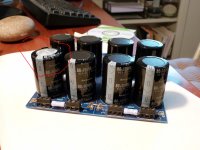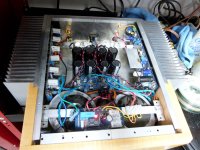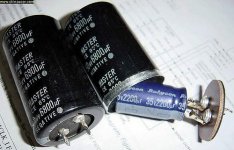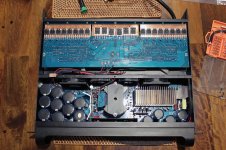I have an idea about this noise problem ...
If an exta capacitor is set betwen the base of Q9 and the tpop of R22 no signal fron input will flow ... and if the noise is from input stage it will disappear.
Then the same with a capacitor from collector of Q10 to the top of R23 no signal will come from VAS
I dont know if this can damage the amplifier .... wait until a more experimented designer make comments ..
Do NOT put a capacitor from collector of Q12 to the bottom of R27 on this side it is a current source .
If an exta capacitor is set betwen the base of Q9 and the tpop of R22 no signal fron input will flow ... and if the noise is from input stage it will disappear.
Then the same with a capacitor from collector of Q10 to the top of R23 no signal will come from VAS
I dont know if this can damage the amplifier .... wait until a more experimented designer make comments ..
Do NOT put a capacitor from collector of Q12 to the bottom of R27 on this side it is a current source .
The best recommendation to locate noise I've seen to date was from AndrewT. Run one channel in isolation first. Get it silent. After this, do the same with the second channel. After they both perform properly, put the two channels together in the amp, and get them silent again. Doing this in stages will give you a better idea where the noise is coming from, and make it much easier to eliminate the noise. Trying to silence a completed amplifier is tough to do. Too many possibilities.
Noise problem solved. Took your advise and rewired the PSU twisting the gnd along with the rail +/-, also twisted the speaker out and gnd and took speaker gnd from board and not from psu. I also discovered that one of the PSU caps had bulged and switched out the psu. I got these 80v caps from EBay, my rails are 60V, guess they're Chinese fakes, thought the price was too good to be true. Anyway the high freq hiss is greatly reduced, actuall need to put my ear on the tweeter to hear it.
Thanks all,
PJN
Thanks all,
PJN
Attachments
I double checked my build, all parts were from Digikey
You omitted the Ebay parts ?
That's a no brainer
I just ordered mica output insulators from China , but never semi's or
especially caps (below).
OS
Attachments
hi (noob question) i just wanted to know if i was to build a honey badger would it be possible for me to power it with a smps like the SMPS500QRv2 from connexelectronic as i have one laying around and as i never built a linear psu before i dont have much knowelege in that area so i would rather go down the smps route (plug + play)
Thanks
Thanks
Thanks
Thanks
The problem that is often ignored is that the speaker demands very high peak currents.
Those currents pass through the amplifier and come from the local supply rail decoupling and/or from the PSU.
If the speaker were to demand a transient of 20Apk, would most of that come from the PSU?
Would the PSU shut down? or go into some form of current limiting to protect itself?
Those currents pass through the amplifier and come from the local supply rail decoupling and/or from the PSU.
If the speaker were to demand a transient of 20Apk, would most of that come from the PSU?
Would the PSU shut down? or go into some form of current limiting to protect itself?
From the specs in the provided link -
"Half Bridge resonant SMPS capable of delivering 500W continuous and 700W peak power. It uses unregulated open loop half bridge resonant topology and the output voltage is within +5 and -10% of the nominal voltage when the current draw is varying from 0-100% and the mains supply voltage is 110V or 230V. The main advantage is lower size and cost compared with a similar regulated SMPS and better efficiency compared with the regulated SMPS's due to the fact that the transformer is driven with almost 50% duty cycle all the time, and the current through the switches has sinusoidal shape, and there are no output inductors. The SMPS features overcurrent protection which limit the output current at about 160% of the maximum power, about 800W. "
That, combined with the reservoir caps on the amp board should be sufficient for music peaks. And 20A, although not impossible, is a pretty darn loud mount of music.
"Half Bridge resonant SMPS capable of delivering 500W continuous and 700W peak power. It uses unregulated open loop half bridge resonant topology and the output voltage is within +5 and -10% of the nominal voltage when the current draw is varying from 0-100% and the mains supply voltage is 110V or 230V. The main advantage is lower size and cost compared with a similar regulated SMPS and better efficiency compared with the regulated SMPS's due to the fact that the transformer is driven with almost 50% duty cycle all the time, and the current through the switches has sinusoidal shape, and there are no output inductors. The SMPS features overcurrent protection which limit the output current at about 160% of the maximum power, about 800W. "
That, combined with the reservoir caps on the amp board should be sufficient for music peaks. And 20A, although not impossible, is a pretty darn loud mount of music.
From the specs in the provided link -
"Half Bridge resonant SMPS capable of delivering 500W continuous and 700W peak power. It uses unregulated open loop half bridge resonant topology and the output voltage is within +5 and -10% of the nominal voltage when the current draw is varying from 0-100% and the mains supply voltage is 110V or 230V. The main advantage is lower size and cost compared with a similar regulated SMPS and better efficiency compared with the regulated SMPS's due to the fact that the transformer is driven with almost 50% duty cycle all the time, and the current through the switches has sinusoidal shape, and there are no output inductors. The SMPS features overcurrent protection which limit the output current at about 160% of the maximum power, about 800W. "
That, combined with the reservoir caps on the amp board should be sufficient for music peaks. And 20A, although not impossible, is a pretty darn loud mount of music.
just to be sure the smps and the honey badger built is all that i would need....i wouldn't need to build anything else psu wise? (btw my smps is a 45v would that be fine if not what voltage would you recommend )
Thanks for the help
the amplifier is very tolerant of supply voltage, ±45Vdc is fine.
What speaker impedances are you likley to use?
8ohms from a regulated supply could easily hit 100W and 4ohms could hit 200W.
Ipk for a sinewave driven to 40Vpk into 4r0 resistor is 8Apk.
Most music that has fast transients can send current peaks exceeding the resistor currents by a factor of >3 and some music even exceeds 5times the resistor currents.
3times 8Apk is 24Apk and 6L6 thought I was exaggerating with my example of 20Apk.
800W into two 45V channels is equivalent to 8.9Apk.
Even 8ohms speakers driven to 100W will be way in excess of that. And a pair of 8ohms channels could easily demand 30Apk if the transients on both channels were conincident.
What speaker impedances are you likley to use?
8ohms from a regulated supply could easily hit 100W and 4ohms could hit 200W.
Ipk for a sinewave driven to 40Vpk into 4r0 resistor is 8Apk.
Most music that has fast transients can send current peaks exceeding the resistor currents by a factor of >3 and some music even exceeds 5times the resistor currents.
3times 8Apk is 24Apk and 6L6 thought I was exaggerating with my example of 20Apk.
800W into two 45V channels is equivalent to 8.9Apk.
Even 8ohms speakers driven to 100W will be way in excess of that. And a pair of 8ohms channels could easily demand 30Apk if the transients on both channels were conincident.
the amplifier is very tolerant of supply voltage, ±45Vdc is fine.
What speaker impedances are you likley to use?
8ohms from a regulated supply could easily hit 100W and 4ohms could hit 200W.
Ipk for a sinewave driven to 40Vpk into 4r0 resistor is 8Apk.
Most music that has fast transients can send current peaks exceeding the resistor currents by a factor of >3 and some music even exceeds 5times the resistor currents.
3times 8Apk is 24Apk and 6L6 thought I was exaggerating with my example of 20Apk.
800W into two 45V channels is equivalent to 8.9Apk.
Even 8ohms speakers driven to 100W will be way in excess of that. And a pair of 8ohms channels could easily demand 30Apk if the transients on both channels were conincident.
The speakers are Troel's CNO-25 i think it says min is 3 ohms
Thanks
Last edited:
That 3ohms minimum may mean they are 4ohms speakers.
I see in re-reading my post that I can't count:
40Vpk into 4r0 results in 10Apk for a 200W sinewave signal.
That would result in 30Apk into a reactive load if the factor were three (3) times the resistor load.
Last edited:
hi iam looking into buying the diyaudio psu board to power my honey badger and i just need to know is there a guide on here on how to build it for the honey badger (as in it gives you the parts needed to use) as this is my first time doing this as i to usually use smps to power my other chip amps
Yes, indeed. One has to wonder how often that situation would occur in a typical (non-sound reinforcement), home listening environment. Worse case scenarios are often not-tempered with normal, real-world, everyday need or experience. Just how much power is 'good enough', and can the PSU handle that 95% of the time?...
That, combined with the reservoir caps on the amp board should be sufficient for music peaks. And 20A, although not impossible, is a pretty darn loud mount of music.
BTW, Cristi at Connexelectronic.com provides some very good SMPS. I use them almost exclusively, except in some of my early amps where I built linear PSUs. They're small, light, efficient, and the craftsmanship speaks for itself! I heartily recommend them.
I would not recommend any of the Asian SMPS's. 20'th century switching tech.
Compare the rails of a 1990 PC SMPS to a new Corsair 2010 600W unit.
21'st century low Rdson MOSFET's + much better control IC's (with PFC) =
> 90% efficiency and just millivolts ripple.
Lab gruppen is one of the only OEM's that is
"on the money" (below).
That is a 40A !! with PFC thermal / current shutdown - nearly zero ripple.
I'm bored with analog design , my next "foray" will be one killer +/- 60V
20A SMPS !!
OS
Compare the rails of a 1990 PC SMPS to a new Corsair 2010 600W unit.
21'st century low Rdson MOSFET's + much better control IC's (with PFC) =
> 90% efficiency and just millivolts ripple.
Lab gruppen is one of the only OEM's that is
"on the money" (below).
That is a 40A !! with PFC thermal / current shutdown - nearly zero ripple.
I'm bored with analog design , my next "foray" will be one killer +/- 60V
20A SMPS !!
OS
Attachments
hi iam looking into buying the diyaudio psu board to power my honey badger and i just need to know is there a guide on here on how to build it for the honey badger (as in it gives you the parts needed to use) as this is my first time doing this as i to usually use smps to power my other chip amps
A linear supply is quite simple once you decide what you want.
Two smaller 300-400VA 40-45- 0 - 40-45 toroid's plus two
35a bridges and 8 X 6800 - 8200uf 80V caps is ideal for dual mono.
I think the DIYA power board is set up for this.
OS
Lab gruppen is one of the only OEM's that is
"on the money" (below).
That is a 40A !! with PFC thermal / current shutdown - nearly zero ripple.
Lab gruppen FP14000 amplifier that you linked does not have PFC, but instead uses good old voltage doubler when running in the 110V part of the world. Also no modern MOSFETS, but instead good old IGBTS, and no modern control ICS, but a discrete built circuit on a small daughterboard. And to top all that off, good old flyback SMPS topology. Everything typical for the end of the 20th century.
I was surprised to find that running an Abletec 53v SMPS (not made in China) with the CRCLC filter from my linear supply I was able to get 1mV ripple in quiescent mode. This supply has high momentary peak current capability but not sure how or if it can work on HB. It seems to power the VHex+ nicely. I have never had such a quiet speaker when no source playing. SMPS says it can supply 900w for peak load for 10ms.
https://www.parts-express.com/pedoc...9111X1517312X7b875e212d341da299515824c5698b2c
http://www.diyaudio.com/forums/class-d/281698-abletec-53v-dual-rail-450w-supply-20-a-12.html
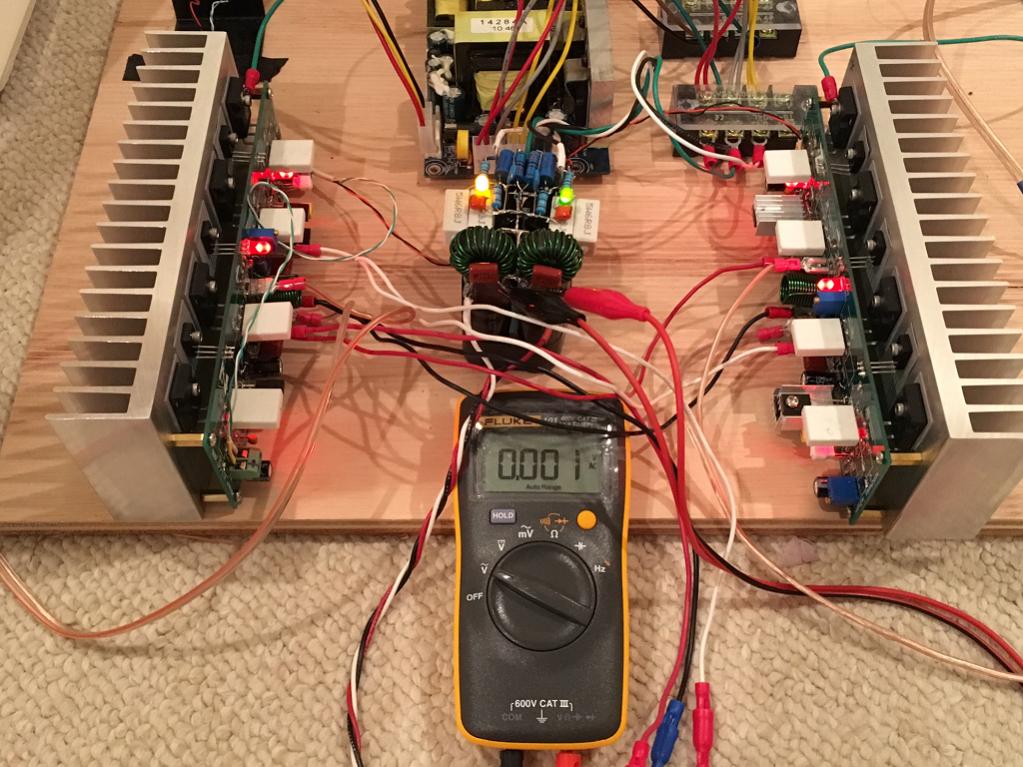
https://www.parts-express.com/pedoc...9111X1517312X7b875e212d341da299515824c5698b2c
http://www.diyaudio.com/forums/class-d/281698-abletec-53v-dual-rail-450w-supply-20-a-12.html

Last edited:
if i was to go off ostripper recomendtions (Two smaller 300-400VA 40-45- 0 - 40-45 toroid's) Is a soft start and speaker protection kit recommended for the honey badger if so can someone recommend a kit either assembled or pcb that would work, the one in the diy audio store works to be around $40 shipped without customs so could work out to be more for just the pcb’s alone
Thanks
Thanks
Last edited:
Speaker protection using a DC detect and speaker isolation relay is mandatory for DC coupled amplifiers. It is also advisable for Amplifiers with a direct coupled output.
Soft start reduces the current during the start up phase of the transformer.
You can use a close rated fuse when using an appropriate added resistance in the primary circuit. If you don't soft start you need to at least double that primary fuse or more likely triple it to survive repeated restarts over many months/years.
A tripled current fuse is mighty big and takes a long time to blow when the transformer is abused.
Soft start reduces the current during the start up phase of the transformer.
You can use a close rated fuse when using an appropriate added resistance in the primary circuit. If you don't soft start you need to at least double that primary fuse or more likely triple it to survive repeated restarts over many months/years.
A tripled current fuse is mighty big and takes a long time to blow when the transformer is abused.
- Home
- Amplifiers
- Solid State
- diyAB Amp The "Honey Badger" build thread
